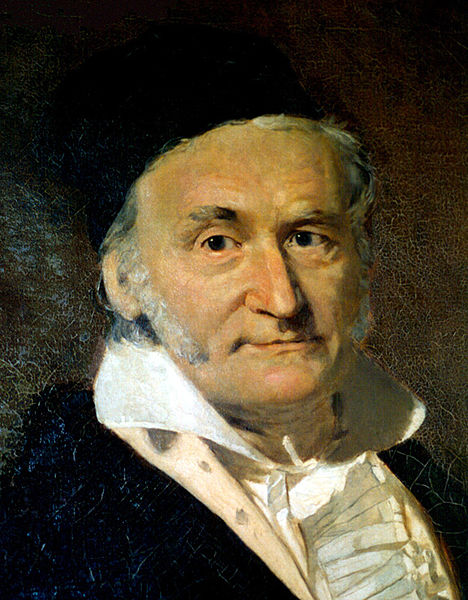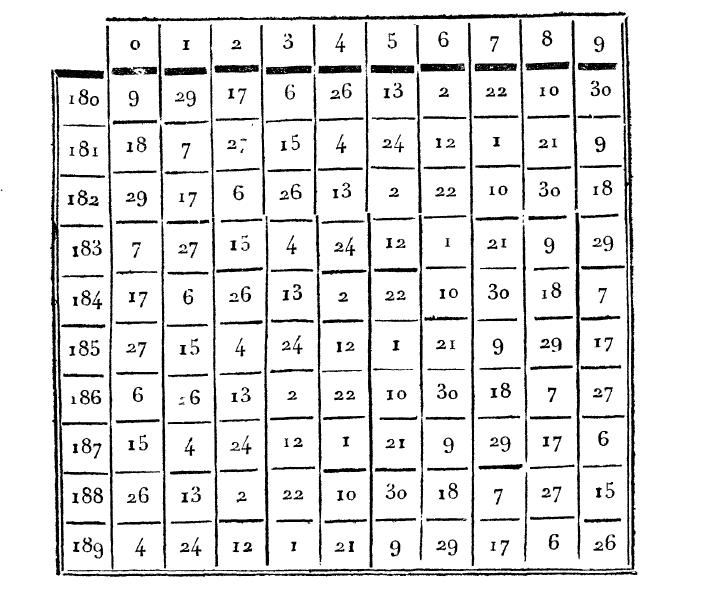- About MAA
- Membership
- MAA Publications
- Periodicals
- Blogs
- MAA Book Series
- MAA Press (an imprint of the AMS)
- MAA Notes
- MAA Reviews
- Mathematical Communication
- Information for Libraries
- Author Resources
- Advertise with MAA
- Meetings
- Competitions
- Programs
- Communities
- MAA Sections
- SIGMAA
- MAA Connect
- Students
- MAA Awards
- Awards Booklets
- Writing Awards
- Teaching Awards
- Service Awards
- Research Awards
- Lecture Awards
- Putnam Competition Individual and Team Winners
- D. E. Shaw Group AMC 8 Awards & Certificates
- Maryam Mirzakhani AMC 10 A Awards & Certificates
- Two Sigma AMC 10 B Awards & Certificates
- Jane Street AMC 12 A Awards & Certificates
- Akamai AMC 12 B Awards & Certificates
- High School Teachers
- News
You are here
Servois' 1813 Perpetual Calendar, with an English Translation - Gauss' Calculation for the Date of Easter
The final portion of Servois' [1813] paper included a table, created by Servois, which could be used to find the date of Easter. His table was created using the algorithm introduced by Johann Carl Friedrich Gauss (177–1855) in 1800. We present a brief discussion of Gauss' algorithm, and then present Servois' table.

Figure 7. Carl Friedrich Gauss. Painting by G. Biermann (1824–1908) (public domain).
Easter is a moveable feast, which means it is not fixed to a particular day of the calendar year. The First Council of Nicaea (325 CE) defined the date of Easter to be the first Sunday after the occurrence of the Paschal Full Moon (the first full moon that occurs on or after March 21) [Richards 1998]. This definition led to the creation of the Easter calculation as a scientific problem for mathematicians and astronomers in the Christian West. Readers interested in an in depth discussion of the date of Easter Sunday should refer to [Richards, pp. 346-383]. There have been many attempts at creating algorithms to calculate the date of Easter; however, here we discuss only Gauss' attempts. Readers interested in a detailed history of Gauss' work should refer to Bien [2004].
In his 1800 paper, “Berechnung des jüdischen Osterfestes,” Gauss presented his calculation for the date of the Paschal Full Moon and the date of Easter. His method has the benefit of being simple, so that a person who is not savvy with mathematics can use it. It does not appear that Gauss created this formula for everyday use. It might be a legend, but some historians, including Bien [2004], claim that Gauss' motive for creating this formula was to calculate his own birth date. His mother had told him that he was born eight days before the Feast of the Ascension on a Wednesday in 1777. Using a slightly different method from the one that we describe below, Gauss was able to find that he was born on April 30.
The formulas for Gauss' algorithm can be found in any encyclopedia; however, some of them are a little mysterious. Reints [2009] provides concise but complete explanations of the meanings of the formulas and of the values used in them. We now provide a brief description of these formulas following Reints [2009]; readers interested in further details should refer to this source.
The details of the calculation are carried out by associating the year \(y\) with a sequence of values \(m,\) \(n,\) \(a,\) \(b,\) \(c,\) \(d,\) and \(e,\) which will result in the determination of the date of the Paschal Full Moon and Easter Sunday in year \(y.\) Gauss stated that for the nineteenth century, one should take \(m = 23\) and \(n = 4.\) What are \(m\) and \(n\)? The value of \(m\) is dependent on the century in question. This value is calculated from the cycle of the dates on which the Paschal Full Moon occurred in that century [Director 1997]. There are about 235 lunations (mean duration of one lunar phase) in 19 tropical years. (A tropical year is the time it takes for the sun to return to the same point in the sky relative to the background stars, as seen by an Earthbound observer.) But these two periods of time are not exactly equal. There is an error of about one day every 310 years, so the value of \(m\) takes this shift into account. The value of \(n\) is based on the cycle of the days of the week on which the Paschal moon occurs in that century. In other words, \(n\) works according to a mod 7 system, with 0 representing Sunday, 1 representing Monday, etc. Now, using the values of \(y,\) \(m,\) and \(n,\) you calculate the following:
- First, calculate \(a = y \mod 19.\) This identifies the location of the year within the Metonic cycle, the 19-year cycle of the phases of the moon alluded to above.
- Next, find \(b = y \mod 4.\) This formula accounts for the 4-year cycle of the leap years in the Julian calendar.
- Then, calculate \(c = y \mod 7.\) This takes into account that a non-leap year is one day longer than 52 weeks.
- Then, calculate \(d = (19a + m) \mod 30.\) This gives the number of days that need to be added to March 21 in order to find out the date of the Paschal Full Moon.
- Finally, find \(e = (2b + 4c + 6d + n) \mod 7.\) This is the number of days from the Paschal Full Moon to the next Sunday.
The Paschal Full Moon will occur \(d\) days after March 21 and Easter Sunday will be March \((22 + d + e).\) If \((22 + d + e)\) is greater than 31, then you roll over into the month of April.
Now, the length of a lunar month is not 30 days, but rather 29.53 days. Therefore, when the value of \(d\) is large this causes the Paschal Full Moon to be one day late. Additionally, if it happens on a Sunday, then we calculate a date of Easter which will be one week overdue. To compensate for this possibility, you must watch for this condition:
- If \(d = 29\) and \(e = 6,\) then replace April 26 with April 19.
- If \(d = 28,\) \(e = 6,\) and \(a > 10,\) then replace April 25 with April 18.
Again, the preceding explanation was taken from Reints [2009], except where noted.
Richards [1998] states that Gauss' 1800 method had a defect in it, namely that Gauss did not correctly account for the lunar equations of the Paschal Full Moon. In other words, there were errors with the equations to calculate the values of \(m\) and \(n.\) (Interestingly, in the second edition of his article, Gauss presented no expressions for \(m\) and \(n,\) but rather gave a table for the values up to the year 2499.) However, his error would not affect his calculations until the year 4200 CE. Bien [2004] reports that there actually were numerous errors in Gauss' original algorithm, and Gauss did not correct all the errors until 1816.
Now, what did Servois do with Gauss' algorithm? Servois used Gauss' 1800 algorithm to create an efficient table which would calculate the date of the Paschal Full Moon without any calculations. (See Figure 8.) Once an individual had the date of the Paschal Full Moon, then she could use Servois' perpetual calendar to find the date of the Sunday after the Paschal Full Moon and that would be Easter Sunday. Therefore, for the nineteenth century, one would need no algorithm to determine the date of Easter Sunday. However, if others tried to imitate Servois' table and create similar tables for different centuries, then, like Gauss' algorithm, these tables would fail to work after the year 4200 CE.
Figure 8. Servois' table for Gauss' algorithm for the date of Easter. (Image used courtesy of the Science, Industry and Business Library of the New York Public Library.)
How does Servois' table (see Figure 8) work? From item (1.) of Gauss' algorithm, the phases of the moon occur on different calendar days from year to year; however, they repeat in cycles every 19 years [Director 1997] and this is the principle upon which Servois' table works. The decades are on the left hand side of the table and the units are above, which Servois compared to a table of logarithms. As a general note, dates that are less than 20 in the table belong to the month of April.
Let's work though an example using Gauss' algorithm and we shall see how efficient Servois' table really is. We will calculate the date of the Paschal Full Moon and the date of Easter Sunday for the year 1827 (the year of Servois' retirement). We let \(y = 1827,\) \(m = 23,\) and \(n = 4.\)
- \(a = 1827 \mod 19 = 3.\)
- \(b = 1827 \mod 4 = 3.\)
- \(c = 1827 \mod 7 = 0.\)
- \(d = \left(19(3) + 23\right) \mod 30 = 20.\)
- \(e = \left(2(3) + 4(0) + 6(20) + 4\right) \mod 7 = 4.\)
Therefore, the Paschal Full Moon occurred on April 10, 1827, and Easter Sunday was April 15, 1827.
Now, let's evaluate the efficiency of Servois' table. In Figure 8, go to the row “182” and over to the unit “7” and you will find that the date of the Paschal Full Moon was April 10, 1827. Turning to Servois' perpetual calendar, we find on which day of the week April 10, 1827 occurred. According to Servois' calendar (see Figure 6), April 10, 1827, was a Tuesday. Therefore, Easter Sunday would have occurred the following Sunday, which was April 15, 1827.
Salvatore J. Petrilli, Jr. (Adelphi University), "Servois' 1813 Perpetual Calendar, with an English Translation - Gauss' Calculation for the Date of Easter," Convergence (June 2012), DOI:10.4169/loci003884





